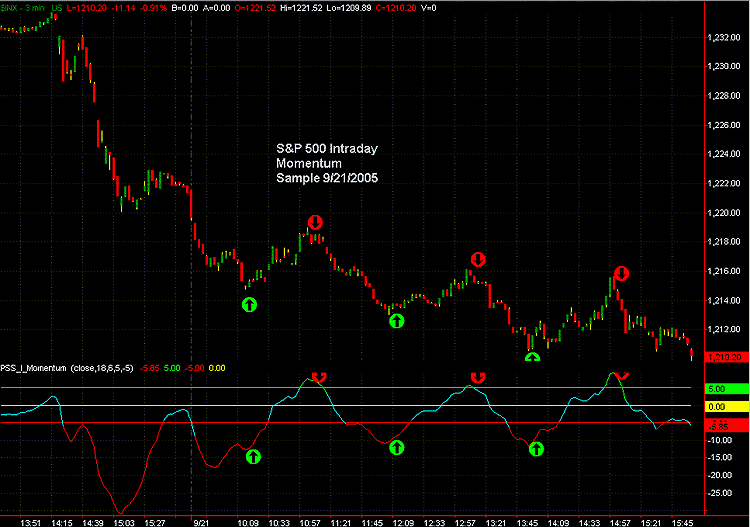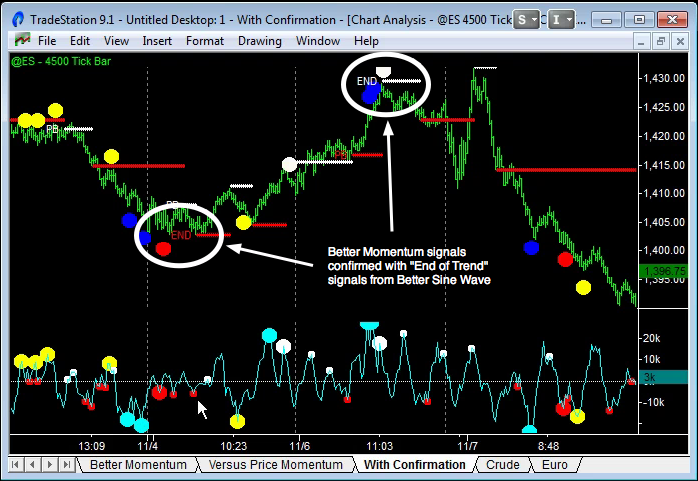Momentum Indicators
Post on: 16 Март, 2015 No Comment

Home Home Momentum Indicators
Momentum Indicators
What is momentum? The term has a specific meaning in physics, and perhaps it is easier to understand the momentum of prices by considering an analogy. We know that the speed of a swinging pendulum will vary along the vertical axis, for example, as the pendulum moves from the bottom to the uppermost extent of its oscillation. Although the vertical movement of the pendulum is zero at the top of its range (since otherwise it would fly away), the forces acting on it at the same point is maximum. Conversely, as the pendulum reaches its maximum speed, the forces generating the speed are at their minimum. The oscillation of force and speed that creates the observed back and forth movement in the pendulum is very similar to the oscillation of prices in the market.
As the prices move between successive extremes, the speed of the price action reaches its maximum at a point where the entry of new traders or money has peaked. Thereafter, the trend will continue to generate new highs in all likelihood unless the continuous nature of the price action is broken by an unexpected event, but since the amount of new buyers or sellers steadily decreases, achieving and sustaining new highs will be harder. And just as the case with the pendulum, as the driving force of the trend dries out (timeframe or size of the trend is irrelevant), opponents of the trend will sooner or later achieve dominance, and will drive the price action in the opposite direction, replicating tick-tock pattern that is familiar to most traders.
Momentum indicators aim to characterize and portray these swings of the price. Needless to say, there are no precise, deterministic rules in trading and technical analysis that can give such satisfactory results as those obtained by the physicist, but the momentum indicators do help us place the price action into the context of trader enthusiasm which then enables the determination of the underlying trend’s strength.
How to use Momentum Indicators
There is of course no rock-solid rule about the use of this type of indicator. A capable trader can create profitable trades even with a most unlikely combination of indicators. On the other hand, there are some common rules that would help many newcomers by restricting them to a less volatile, less emotional course of action. This section is mostly aimed at supplying such a set of rules.
Momentum indicators are not directional indicators. They are most beneficial in the context of an existing trend already identified by a trader who is unsure about when to join the same. In other words, we know our destination, and we know the vehicle that we’ll board, but we would like to board it at such a time and under such conditions that the risk of an accident or crash is minimal. Momentum indicators facilitate this task by telling us when the trend has enough fuel to burn, so to speak, in volume, trader enthusiasm, and overall market dynamism. For instance, when using the stochastics indicator, a trader may choose to exploit a crossover as a sign that the trend has achieved enough momentum to justify a new trade. In a range pattern, the RSI may be used to determine reversals which are equivalent to the highs or lows of the pendulum.
Another, and perhaps more popular way of using momentum indicators is making use of them in light of the divergence/convergence phenomenon. In this case, the trader does not seek to confirm the price action with a favorable momentum signal, and aims, instead, to identify the price levels where momentum is contradicting the price action. We had discussed that the net force acting on a pendulum will be zero when it reaches its greatest speed at its highest or lowest level. Similarly, the trader seeks out phases of the market action where momentum is falling rapidly, while the price action accelerates towards a point of reversal. When that point is reached, we enter a counter-trend position with the aim of benefiting from the ensuing correction.
Types of Momentum Indicators
Momentum indicators are both popular and numerous. By definition, they are also oscillators, and all the general principles that apply to oscillators discussed in the relevant articles apply to momentum indicators as well. Here we’ll mention a few examples briefly, in order to preserve the completeness of our presentation.
-Oscillators: Oscillators such as the RSI, MACD, CCI or Stochastics indicators are momentum indicators as well. They swing back and forth between predetermined levels, and can be traded on the basis of the divergence/convergence phenomenon, as well as the simpler crossover techniques.
-Momentum Indicator
As its name indicates, this indicator is dedicated to measuring the impulse of the trend. It is perhaps the most basic type of momentum indicator.

-Rate of Change
An advanced version of the momentum indicator, the rate of change indicator presents an easier-to-interpret, more refined picture of the market’s emotional configuration, and is useful in any market that displays a strong tendency to oscillate.
The Williams Oscillator is also a momentum indicator.
Many guides and textbooks on technical analysis tend to restrict momentum indicators to range trading, but it is perfectly possible to use them in trends provided that one solidifies their signals through confirmation from another class of indicators that is more suitable to a trending market.
We’ll also discuss each of these indicators in their separate articles in greater detail.
Conclusion
Momentum indicators should be used with other types of indicators that establish directionality. Combining them with Fibonacci indicators, which generate far more precise trading points for exploitation, is also a reliable technique. Although there are a large number of indicators that measure momentum, it is probably not a good idea to use more than one of them on a single trade. And especially in strongly directional markets, such as those where developing bubbles are dominant, it is not a great idea to depend too much on momentum readings, even when strong divergence/convergence patterns exist.














